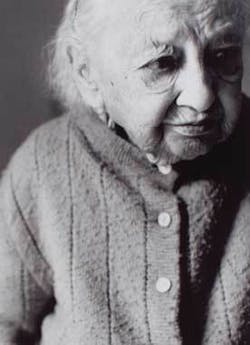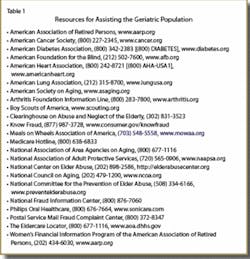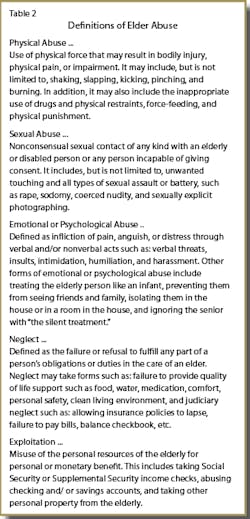A Look at Elder Abuse in America
Looking over my appointment book last week I was thrilled to see some of my favorite geriatric patients scheduled. Throughout my clinical dental hygiene career, I have met some of the most interesting, smart, funny, and insightful senior citizens. I have had the privilege of treating patients who were survivors of Nazi prison camps, some who have told stories of traveling to work via horse and buggy, others who have reminisced about growing up in the Great Depression, and one gentleman who actually witnessed the Wright Brothers’ famous first flight in Kitty Hawk, N.C. I have appreciated the many history lessons my geriatric patients have given me over the years. Last year, President Bush said, “Older Americans help others to understand the past, and they teach timeless lessons of courage, endurance, and love. Through their legacy of patriotism, service, and responsibility, America’s seniors also unite families and communities and serve as role models for younger generations.” I couldn’t agree more. However, not all of society extends this care and respect for the elderly.
Aging is a complex and fascinating process. In the not-so-distant future, we will be faced with the reality of more Americans over the age of 65 than ever before. On July 1, 2004, 12 percent of all Americans were over the age of 65.1 The Census Bureau also reports that by the year 2050, people age 65 and over will comprise an impressive 21 percent of the U.S. population.1 Older people are not only becoming a larger percentage of the population, but they are also living longer ... and living longer with teeth. It is estimated that as recently as half a century ago, more than two-thirds of Americans over age 75 were edentulous.2 In 1987, less than one-third of Americans over age 75 were edentulous.3 Based on this statistic, if this trend continues, our dental hygiene schedules will be comprised of dentate geriatric patients for years to come. The frequency of preventive dental hygiene care for this dentate senior population gives dental hygienists an excellent opportunity to assess not only oral health but general health on a regular basis. One aspect of health assessment for senior patients is the estimation of their quality of life, a facet of which is the careful evaluation of self-care and/or quality of care by outside sources, such as health-care providers, assisted living support personnel, and/or family/friend caregivers. At each senior citizen dental hygiene appointment we must ask ourselves, “How well is Mrs. Doe doing with self-care?” and, if appropriate, “How well are others caring for her?”
Elder abuse is a sad reality for many senior citizens. No one knows exactly how many U.S. senior citizens are being abused, neglected, or exploited, because many cases go undetected and are often underreported. After all, abuse, in general, is a problem that remains hidden in many American families. In 1996, the National Association of Adult Protective Services Administrators National Center on Elder Abuse reported disturbing findings:4
• Adult Protective Services (APS) completed 364,512 investigations of reported abuse, neglect, or exploitation involving older persons living at home (in private, noninstitutional settings). Of these investigations, 43 percent (156,740) were confirmed.
• Over the past 10 years, the number of elder domestic abuse investigations by APS has increased by more than 150 percent.
• Sadly, domestic elder abuse is most commonly (90 percent) committed by family members.
In 1987, the federal government, via the Amendments to the Older Americans Act, first defined elder abuse, neglect, and exploitation. In general, there are three basic categories of elder abuse: self-neglect/self-abuse, domestic elder abuse, and institutional elder abuse.
Self-neglect/self-abuse is the result of an inability of seniors to provide themselves with the actions to promote health and prevent physical harm, emotional harm, or pain. Dental hygienists are on the front lines in observing the self-care habits of their senior patients. Some of the common signs that may indicate a failure to promote self-care in senior patients are: malnutrition, poor body hygiene, poor oral hygiene, failure to comply with medical/dental needs, failure to comply with medication protocols, failure to comply with bill payment, failure to keep a clean home, and disinterest in social/family interactions. It is shocking to see a patient spiral into self-neglect/self-abuse. Why does this happen? There are several potential reasons. Depression can play a role in the etiology of self-neglect/self-abuse. Such depression could stem from a variety of sources that are commonly experienced by seniors such as: death of a spouse, death of family members and/or lifelong friends, empty nest syndrome, loss of independence, chronic pain, financial worries, etc. Geriatric specialists recommend several mechanisms to aid seniors who are experiencing problems with self-neglect/self-abuse. In some instances, the source of self-neglect/self-abuse must be addressed and monitored by a medical professional and/or social worker. For other individuals, support in activities of daily living can help ease the loneliness, helplessness, and burden many seniors face. Most communities in the United States have organizations which support senior citizens such Meals on Wheels, AARP, and Boy Scouts of America. See Table 1 for a comprehensive list of resources for dental hygienists to use in assisting their senior patient population.
Federal definitions further break down domestic and institutional elder abuse into the following subcategories: physical abuse, sexual abuse, emotional or psychological abuse, neglect, and exploitation. Specific types of domestic and institutional elder abuse are outlined in Table 2. The National Association of Adult Protective Services outlines a list of descriptions that are possible indicators of abuse, neglect, or exploitation (Table 3). These signs may require the dental hygienist and dentist to inform law enforcement or Adult Protective Services.3
The sad reality of elder abuse is that it is likely to increase as the number of elderly individuals continues to rise. Without question, dental hygienists play a vital role in providing preventive and nonsurgical therapy for geriatric dental patients.
Philips Oral Healthcare’s Professional Education department (www.sonicare.com) offers an excellent continuing-education course on geriatric issues. Dental hygienists can use this course as a rich resource for expanding their knowledge of geriatric issues. Ideally, through a multidisciplinary approach, through use of various community and governmental resources, and with the support of the dentist and entire dental team, dental hygienists can continue to expand their advocacy roles in the care of the elderly.
null





